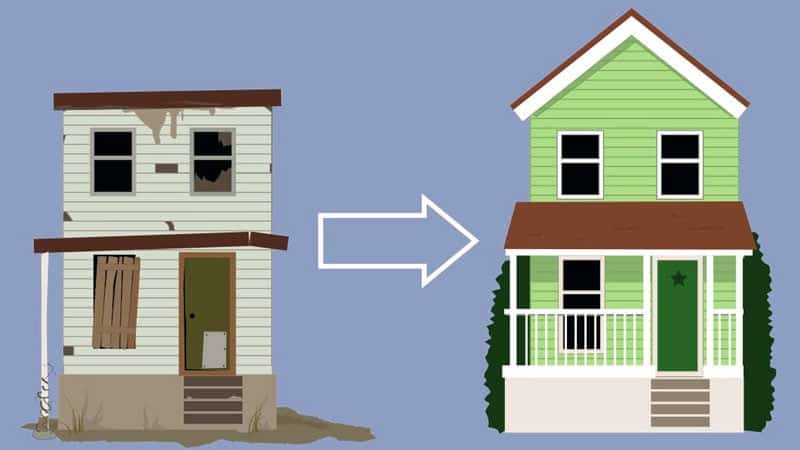Flipping Houses: The Fast Track to Profit

The dream of buying a run-down property, transforming it, and selling it for a significant profit has captivated entrepreneurs for decades. This high-stakes, high-reward strategy—known as house flipping—offers one of the quickest paths to generating substantial capital in real estate. But this fast track is not a casual stroll; it's a sprint that demands careful planning, iron-clad budgeting, and an eye for hidden potential.
Flipping a house is more than just a renovation project; it is a business model. Success hinges on a simple equation: buy low, renovate smart, and sell high. The profit you realize is the final sale price minus the total costs: purchase price, renovation expenses, and holding costs (mortgage interest, taxes, insurance, and utilities). To navigate this process successfully, beginners need a detailed playbook.
1. Mastering the Finances: The 70% Rule and Budgeting
Before you ever step foot into a potential flip property, your most critical job is to establish a rigorous financial framework. Flipping requires substantial capital and meticulous cost control.
The 70% Rule
The first and most fundamental rule for house flippers is the 70% Rule. This guideline helps you determine the maximum price you should pay for a distressed property.
The rule states that an investor should pay no more than 70% of the After Repair Value (ARV) of the property, minus the total estimated repair costs (Rehab Costs).
Maximum Offer Price=(0.70×ARV)−Rehab Costs
The ARV is what the property is expected to sell for after all repairs and upgrades are completed. By adhering to this rule, you ensure a sufficient profit margin to cover all expenses, including unforeseen complications, which are nearly inevitable.
Budgeting for the Unexpected
A common mistake for new flippers is underestimating costs. Always build a contingency fund—typically 10% to 15% of your total renovation budget—into your financial plan. This reserve is essential for covering surprises like unexpected structural issues, mold, old plumbing that needs replacement, or necessary changes to your original design plan.
2. Finding the Deal: Identifying Profitable Properties
The biggest profits are made not when you sell, but when you buy right. Your ability to locate a property significantly undervalued due to distress is the key to the entire operation.
Knowing Your Market
Before searching for a property, you must master the local market. Research what buyers in your target neighborhood want. Are they looking for open-concept kitchens? High-end finishes? A small, family-friendly yard?
- Location, Location, Location: Focus on neighborhoods with strong resale potential. Look for areas on the cusp of revitalization—improving school districts, new local infrastructure, or high employment growth.
- Target the "Good Bones": The ideal flip property has a solid foundation and structure but suffers from cosmetic obsolescence (old kitchens, dated bathrooms, worn-out flooring). Avoid properties with major structural red flags like foundation damage, extensive water damage, or environmental hazards like asbestos or lead paint, as these repairs are costly and time-consuming.
Hunting for Distressed Properties
The best deals are often found off the beaten path. Look beyond standard MLS listings:
- Driving for Dollars: Physically drive through neighborhoods looking for visual cues of neglect: overgrown lawns, peeling paint, broken windows, or excessive junk mail. Contact the owners directly with a personalized offer.
- Public Records: Scour public records for signs of financial distress, such as pre-foreclosures, delinquent property taxes, or properties being sold through Probate (an estate sale after an owner's death).
- Networking: Build strong relationships with wholesalers and real estate agents specializing in investment properties. They often have access to off-market deals that never hit the public listings.
3. Securing Capital: Financing Your Flip
Flipping houses is capital-intensive. While paying cash is ideal for leverage and speed, most investors use various financing methods. Traditional bank loans are often difficult to secure for distressed properties, which may not be "mortgageable" in their current state.
Short-Term Financing Options:
- Hard Money Loans (HMLs): These are short-term loans provided by private individuals or companies, not traditional banks. They are secured by the property itself. HMLs are fast, can close in days, and often finance the purchase and a portion of the renovation. However, they come with higher interest rates and shorter repayment terms (typically 6-18 months).
- Private Lenders: Loans from family, friends, or independent private investors can offer more flexible terms than HMLs.
- Home Equity: If you own a primary residence, a Home Equity Line of Credit (HELOC) or a Cash-Out Refinance can provide capital based on the equity you've already built.
4. The Transformation: Renovation and Project Management
Once the property is secured, the renovation phase begins. Speed is crucial, as every day you hold the property is another day of mounting holding costs eating into your profit.
Assemble Your Power Team
You cannot successfully flip alone. Your network is your net worth in this business.
- Contractors: Find a reliable, licensed, and insured General Contractor (GC). Get multiple bids for every job. Your GC should provide a detailed timeline and stick to it. Include a clause in your contract with penalties for missed deadlines.
- Real Estate Agent: Partner with an experienced flipper-friendly agent who understands investor needs, not just residential sales. They will help you accurately determine the ARV and list and market the finished product effectively.
- Other Professionals: Establish relationships with inspectors, title companies, and real estate attorneys.
Focus on High-Return Upgrades
Successful flippers focus on projects that deliver the highest return on investment (ROI). You are renovating for the masses, not for your personal taste. Kitchens and bathrooms are the biggest drivers of resale value.
- Essential Updates: New paint (neutral colors), updated lighting, new flooring, and curb appeal enhancements (landscaping, new door, fresh exterior paint).
- Avoid Over-Renovating: Do not install top-of-the-line luxury finishes in a mid-range neighborhood. Your goal is to meet the market expectations, not exceed them, which simply kills your profit margin.
5. Exit Strategy: Marketing and Selling Quickly
The final step is the successful sale. The renovation isn't finished until the closing documents are signed.
Pricing and Staging
Work with your agent to price the home correctly from day one. Overpricing a flipped home will cause it to sit on the market, racking up holding costs. You need a quick sale.
- Staging Sells: Have the home professionally staged. Staged homes sell faster and for higher prices than empty ones, allowing potential buyers to better visualize the space.
- Highlight the New: Showcase the quality of the renovations. Provide a list of all new upgrades (roof, HVAC, plumbing, appliances) to give buyers confidence in the home’s longevity.
Risks and Rewards: A Balanced View
While the rewards of house flipping are significant—the potential for a fast, substantial profit and the satisfaction of transforming a neglected home—the risks are equally large.
| Rewards | Risks |
| High Potential Profit | Budget Overruns (Unforeseen repairs) |
| Quick Return on Capital (Average flip time is 6 months) | High Holding Costs (If the sale is delayed) |
| Active Income Generation | Market Fluctuations (A real estate downturn can erase profit) |
| Skill Development (Project management, negotiation, construction knowledge) | Project Stress (Delays, contractor issues, missed deadlines) |
Conclusion: Ready to Take the Leap?
Flipping houses is a powerful, active strategy for real estate wealth creation, but it is not a get-rich-quick scheme. It is a calculated venture requiring investors to act like meticulous project managers and savvy business owners. By strictly adhering to the 70% rule, building a reliable team, and planning for every financial contingency, you can successfully navigate the process and find your own fast track to profit.
Are you ready to commit the time and capital required to turn potential into profit in your local real estate market?

Related